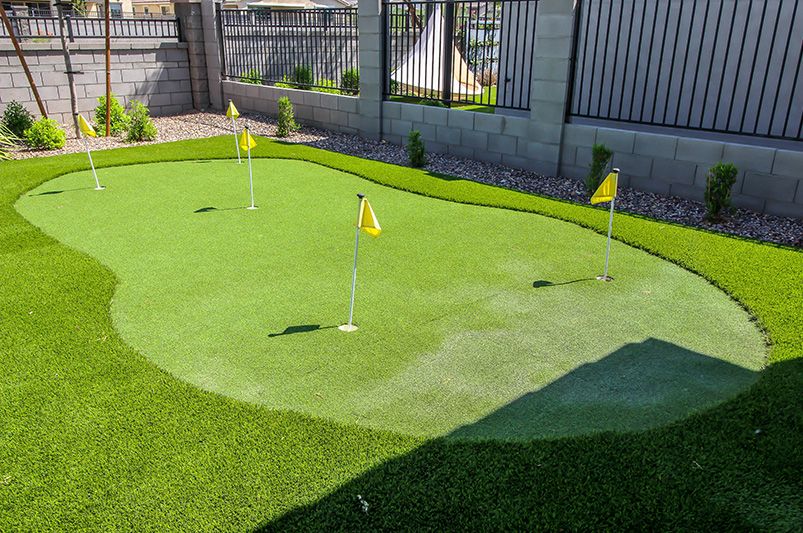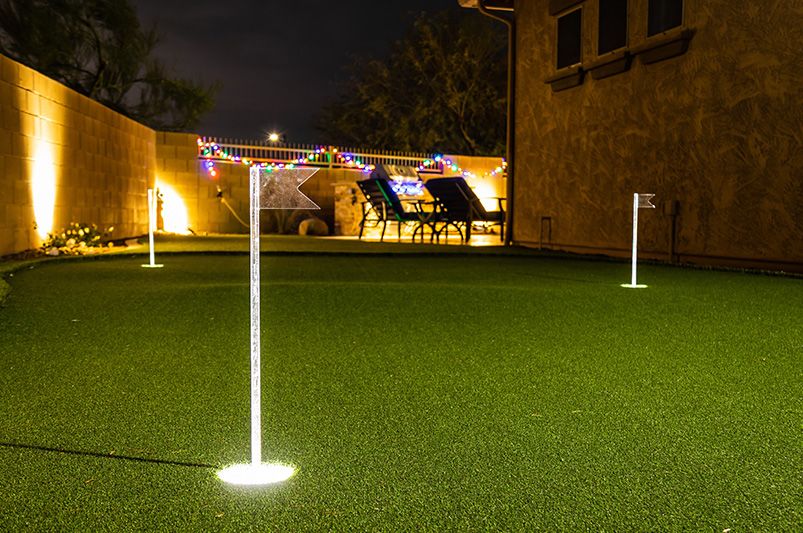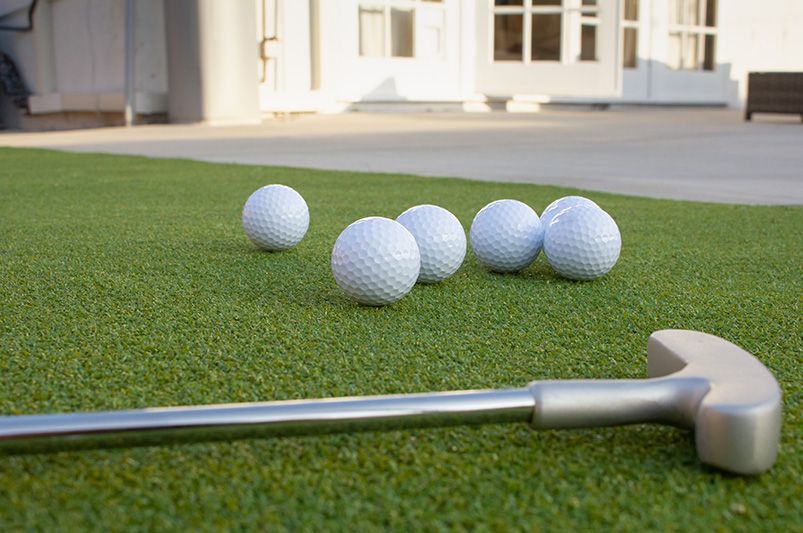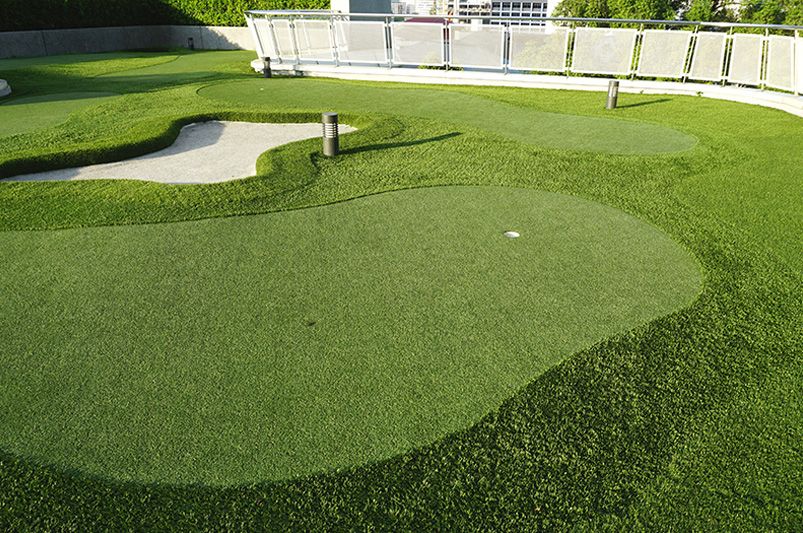
Backyard Putting Greens: Design, Benefits, and Maintenance
By Maged Ahmed Published: 28/08/2024 | Updated: 28/08/2024
Backyard Putting Greens: Design, Benefits, and Maintenance
A backyard putting green is more than just a luxury—it's a dream come true for golf enthusiasts and a fun, engaging addition for families. Whether you're looking to improve your short game without leaving home or simply want to add a unique feature to your outdoor space, a putting green offers countless benefits. As this trend continues to grow, more homeowners are considering the possibilities and advantages of bringing a piece of the golf course right into their own backyard.


At ShrubHub, we're dedicated to helping you create outdoor spaces that not only look beautiful but also enhance your lifestyle. Our blog is packed with tips, design ideas, and expert advice to help you make the most of your yard. Whether you're a seasoned golfer or just love the idea of a low-maintenance, fun outdoor space, a backyard putting green might be the perfect addition to your home.
In this article, we’ll explore the essential things you need to know before installing a backyard putting green, from the benefits and types of greens available to the steps involved in preparation, maintenance, and customization.
Benefits of Installing a Backyard Putting Green
Installing a backyard putting green offers a variety of benefits that go beyond simply enhancing your golf game. For avid golfers, the convenience of having a practice space just steps away from your door is invaluable. It allows you to work on your short game whenever you have a spare moment, improving your skills and lowering your scores over time. No more driving to the golf course or paying for practice time—your backyard becomes your personal training ground.
But the advantages extend far beyond practice. A well-designed putting green can significantly boost the aesthetic appeal of your property, creating a lush, green focal point that stands out in your landscape. This addition can increase your home’s value, making it an attractive feature for potential buyers who appreciate the unique blend of leisure and luxury.
Moreover, a backyard putting green isn’t just for golfers. It provides a fun and engaging recreational space for the whole family. Kids can enjoy mini-golf games, and it offers a unique way to entertain guests during gatherings. It’s a feature that promotes outdoor activity, bringing people together in a relaxed, enjoyable environment.
Whether you're looking to improve your golf skills, elevate the look of your backyard, or simply add a fun element for family and friends, a backyard putting green is a versatile and valuable investment.
Types of Putting Greens
When considering a backyard putting green, one of the first decisions you’ll need to make is whether to opt for natural grass or artificial turf. Each option has its own set of advantages and potential drawbacks, so it's important to choose the one that best fits your needs, lifestyle, and maintenance preferences.
Natural Grass Putting Greens
Natural grass putting greens offer an authentic golfing experience, with the look and feel of a traditional golf course. The softness of real grass underfoot and the natural variations in texture provide a truly immersive playing environment. However, maintaining a natural grass putting green requires significant effort. Regular mowing, watering, fertilizing, and pest control are essential to keep the grass healthy and at the optimal playing height. Additionally, natural grass is more susceptible to weather conditions, which can affect the quality of play.

Artificial Turf Putting Greens
On the other hand, artificial turf putting greens are a low-maintenance alternative that has become increasingly popular. Modern synthetic turfs are designed to closely mimic the appearance and feel of natural grass, offering a consistent surface that’s perfect for practicing your putt. The biggest advantage of artificial turf is its durability and ease of care. It requires no watering, mowing, or fertilizing, and it can withstand various weather conditions without significant wear. Artificial turf is also highly customizable, allowing you to create a green that fits your space and style perfectly.
Choosing the Right Option
When deciding between natural grass and artificial turf, consider factors like maintenance, cost, and your personal preference for playing surface. Natural grass may be ideal for those who love the authentic experience and are willing to invest time in upkeep. Artificial turf, meanwhile, is perfect for those seeking a long-lasting, low-maintenance solution that still offers great playability. Ultimately, the best choice is the one that aligns with your lifestyle and how you plan to use your putting green.
Site Selection and Preparation
Choosing the right location for your backyard putting green is crucial for both its functionality and longevity. The ideal site should be relatively flat, well-drained, and receive ample sunlight to ensure the best playing conditions, especially if you’re opting for natural grass. However, even if your yard has some slopes or uneven areas, these can often be leveled or incorporated into the design to add some challenging features to your green.
Site Selection
Start by assessing your yard to identify the best spot for your putting green. Consider the proximity to your home, the surrounding landscape, and how the putting green will integrate with other outdoor features. Avoid areas that are prone to waterlogging or excessive shade, as these conditions can lead to drainage issues and affect the quality of the turf, especially with natural grass. For artificial turf, while it is more versatile, selecting a location that allows for easy access and visibility will enhance the overall enjoyment and use of the space.
Site Preparation
Once you’ve selected the perfect spot, proper site preparation is essential to ensure the long-term success of your putting green. Begin by clearing the area of any debris, rocks, or vegetation. If necessary, excavate the site to create a level base. For both natural grass and artificial turf, it’s important to install a well-compacted base layer, typically composed of crushed stone or gravel, which provides stability and aids in drainage.
Next, ensure that the site has proper drainage to prevent water from pooling on the surface. This may involve grading the area slightly to allow water to flow away from the green or installing a drainage system underneath. For natural grass greens, you’ll also need to prepare the soil by adding a layer of topsoil and any necessary soil amendments to promote healthy grass growth.
Taking the time to carefully select and prepare the site for your putting green will not only enhance its performance but also extend its lifespan. Whether you choose natural grass or artificial turf, a well-prepared site is the foundation for a smooth, consistent playing surface that you can enjoy for years to come.

Maintenance and Upkeep
Maintaining your backyard putting green is essential to keep it looking great and performing well, whether you have chosen natural grass or artificial turf. Each type of green comes with its own set of maintenance requirements, so understanding what’s involved will help you keep your putting green in top condition.
Natural Grass Putting Greens
For those who prefer the authentic feel of natural grass, regular maintenance is key. Natural grass putting greens require frequent mowing to keep the grass at the ideal height for putting, typically around 1/8 to 1/4 inch. It’s also important to water the green regularly, especially during hot and dry periods, to prevent the grass from drying out. Fertilizing your lawn every few weeks with a balanced fertilizer will keep the grass healthy and green, while aerating the soil periodically will help with water absorption and root growth.
In addition to mowing, watering, and fertilizing, natural grass putting greens may need periodic dethatching and topdressing to maintain a smooth, even surface. Dethatching removes the layer of dead grass and roots that can accumulate at the soil’s surface, while topdressing involves adding a thin layer of sand or soil to level the surface and improve drainage.
Artificial Turf Putting Greens
Artificial turf putting greens are much easier to maintain compared to natural grass, but they still require some care to keep them looking their best. Routine maintenance includes brushing the turf fibers to keep them upright and free from debris. This can be done with a stiff broom or a specialized turf brush. You should also rinse the surface occasionally to remove dust and dirt, and use a mild soap solution to clean up any spills or stains.
One of the major advantages of artificial turf is that it doesn’t require mowing, watering, or fertilizing, which significantly reduces maintenance time and costs. However, it’s important to regularly inspect the seams and edges of the turf to ensure they remain secure. If you live in an area with harsh weather conditions, such as heavy snow or intense heat, you may also need to take additional steps to protect the turf, such as covering it during winter or applying UV-protectant sprays.
Seasonal Considerations
No matter which type of putting green you choose, seasonal maintenance is an important consideration. Natural grass greens will need extra care during the growing season, with more frequent mowing and watering, while in the winter, you may need to reduce these activities or cover the green to protect it from frost damage. Artificial turf, while more resilient, can also benefit from seasonal care, such as protecting it from heavy snowfall or cleaning it more thoroughly after periods of high use.
By following a regular maintenance routine tailored to your type of putting green, you’ll ensure that it remains a beautiful and functional feature in your backyard, providing endless enjoyment and practice opportunities.

Design and Customization Options
One of the most exciting aspects of installing a backyard putting green is the ability to customize it to suit your personal style, space, and golfing needs. Whether you’re looking for a simple, flat putting surface or a more complex design with challenging features, there are endless possibilities to create a unique and functional addition to your outdoor space.
Personalizing Your Putting Green
Start by considering the overall layout and shape of your putting green. Depending on the available space, you can opt for a traditional rectangular design or get creative with curves and irregular shapes that complement your landscape. Incorporating multiple holes at varying distances can add to the challenge and enjoyment, allowing you to practice a wider range of putts.
Adding Features for Extra Challenge
To mimic the experience of playing on a professional golf course, you might want to include additional features such as undulations, sand traps, or fringe areas. Undulations—small hills and valleys on the green—can make putting more challenging and realistic, helping you improve your skills. Sand traps can be installed around the green to practice bunker shots, adding an extra element of difficulty to your practice sessions. Fringe areas, made of slightly longer turf, can be included around the edges of the green to simulate the transition from the fairway to the putting surface.
Integrating with Existing Landscaping
Your putting green doesn’t have to be an isolated feature in your backyard; it can seamlessly blend with your existing landscaping. Consider surrounding your green with plants, shrubs, or flower beds to create a natural, cohesive look. Pathways made of stone or pavers can connect your putting green to other areas of your yard, such as a patio or outdoor seating area, making it an integral part of your outdoor living space.
Lighting and Additional Accessories
For those who want to extend their practice sessions into the evening, adding lighting around your putting green is a great option. Solar-powered or LED lights can be installed around the perimeter to illuminate the green, allowing you to enjoy your putting practice after sunset. Other accessories to consider include benches, storage boxes for your golf equipment, or even a small gazebo for shade and relaxation between practice sessions.
By customizing your backyard putting green to fit your specific preferences and needs, you can create a space that’s not only functional but also a reflection of your personal style. Whether you prefer a simple design for casual practice or a more elaborate setup with multiple features, the possibilities are endless.
Conclusion
A backyard putting green is a perfect blend of luxury, functionality, and fun. Whether you’re an avid golfer looking to refine your short game or simply want to add a unique and engaging element to your outdoor space, a well-designed putting green offers countless benefits. From the convenience of practicing at home to enhancing the aesthetic appeal of your yard, the investment in a backyard putting green is one that pays off in many ways.
At ShrubHub, we specialize in creating custom outdoor spaces that fit your lifestyle and preferences. If you’re considering adding a putting green to your backyard, our expert team is here to help you every step of the way, from design to installation. We offer a wide range of services, including 3D custom landscape designs that bring your vision to life and a variety of high-quality materials to ensure your putting green is built to last.
Explore our website at ShrubHub.com to learn more about how we can help you create the backyard of your dreams. Whether you're looking for professional advice, design inspiration, or a trusted team to bring your ideas to life, we're here to make it happen. Contact us today to get started on your backyard transformation!


